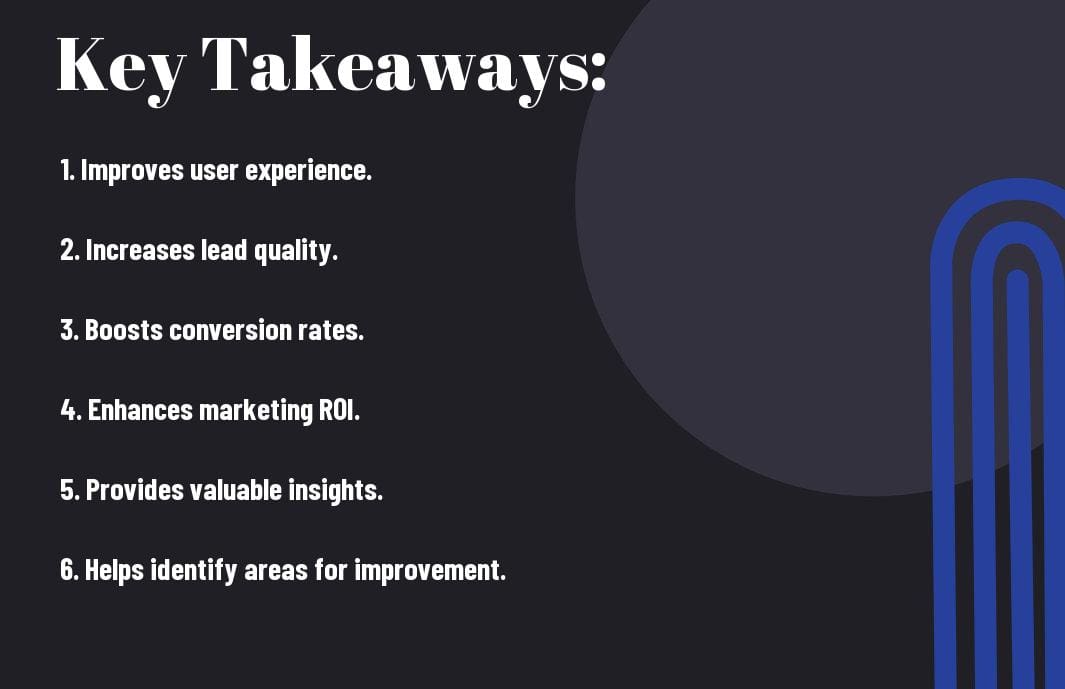Just imagine having a constant stream of leads flowing into your business, significantly boosting your revenue with minimal effort. This is the power of Conversion Rate Optimization (CRO) when it comes to lead generation. By strategically fine-tuning your website and marketing efforts, you can dramatically increase the number of visitors that turn into leads, ultimately driving more sales for your business.
Key Takeaways:
- Improved Lead Generation: Conversion rate optimization helps in increasing the number of leads generated from a website or landing page.
- Enhanced User Experience: By optimizing the conversion process, businesses can provide a better user experience, leading to higher chances of converting leads into customers.
- Maximized ROI: A well-executed conversion rate optimization strategy can lead to higher conversion rates, ultimately maximizing the return on investment (ROI) for the business.

The Basics of Conversion Rate Optimization
Defining Conversion Rate and Its Importance
Basics: You can think of conversion rate as the percentage of website visitors who take a desired action, whether it’s filling out a contact form, making a purchase, or signing up for a newsletter. It’s a crucial metric for measuring the effectiveness of your marketing efforts and how well your website is performing in turning visitors into leads or customers. Conversion rate optimization (CRO) is the process of improving your website to increase the likelihood that visitors will complete the desired action.
Core Principles of CRO
Conversion: At the core of CRO is understanding your target audience and their behavior. By analyzing data and user interactions, you can identify pain points in the conversion process and optimize the user experience to make it easier for visitors to convert. This involves elements such as clear call-to-actions, streamlined navigation, compelling content, and a user-friendly design.
Rate: One of the core principles of CRO is testing and iterating. A/B testing, multivariate testing, and other techniques help you identify what works best for your website and audience. By continuously testing different variations of your website elements, you can improve your conversion rate over time and achieve better results. It’s important to track and analyze data to make informed decisions and refine your strategies for optimal performance.
How CRO Impacts Lead Generation
The Significance of Qualified Leads
For businesses, qualified leads are crucial for successful conversions and revenue generation. By implementing conversion rate optimization (CRO) strategies, companies can attract leads that are more likely to convert into paying customers. This targeted approach not only improves the quality of leads but also increases the overall conversion rates, leading to higher sales and business growth.
Enhancing User Experience for Better Conversions
Enhancing the user experience is a key component of conversion rate optimization (CRO). By optimizing website usability, speed, and design, businesses can create a seamless online experience that encourages visitors to take action. A user-friendly website not only improves conversion rates but also helps in building brand credibility and trust among visitors.
Qualified leads are more likely to engage with a website that offers a smooth and intuitive user experience. By focusing on CRO to enhance user experience, businesses can increase user engagement, reduce bounce rates, and ultimately drive more conversions.
Elements of Effective Conversion Rate Optimization
Call-to-Action Optimization
Optimization of call-to-action (CTA) buttons is a critical aspect of conversion rate optimization. A well-designed CTA should be clear, visually appealing, and placed strategically on the website to attract the attention of visitors. The copy on the CTA should be compelling and action-oriented, prompting users to take the desired action, whether it’s signing up for a newsletter, downloading a resource, or making a purchase.
Landing Page Strategies
To improve conversion rates, landing pages must be tailored to the specific needs and interests of the target audience. A landing page should have a clear and concise message that aligns with the ad or link that directed the visitor to the page. It should have a clean layout, relevant imagery, and persuasive copy that highlights the benefits of the product or service. Additionally, a prominent CTA should be displayed above the fold to make it easy for visitors to take action.
For instance, using A/B testing can help determine which elements of a landing page are most effective in driving conversions. By testing different versions of a landing page, marketers can identify what resonates best with their audience and make data-driven decisions to optimize performance.
Form Optimization and Minimizing Friction
For form optimization and minimizing friction, it is vital to keep forms simple and only ask for vital information to reduce barriers to conversion. Forms should be easy to fill out, with clear instructions and minimal fields required. Additionally, using autofill capabilities can streamline the process for users, making it more likely for them to complete the form and convert.
The design and placement of the form on the landing page can also impact conversion rates. A well-designed form that is prominently displayed and visually appealing is more likely to attract user attention and encourage form submissions. It is crucial to continuously monitor and optimize form performance to ensure a seamless user experience and maximize conversions.
Using Data to Drive CRO Strategies
Importance of A/B Testing
Many successful businesses recognize the significance of utilizing data-driven strategies to optimize their conversion rates. A/B testing is a powerful method used to compare two versions of a webpage or marketing element to determine which performs better in terms of driving conversions. With A/B testing, you can experiment with different elements such as headlines, call-to-action buttons, images, or colors to see which combination resonates better with your target audience.
Analyzing User Behavior for Improved Conversions
With the plethora of analytical tools available today, it is important to analyze user behavior on your website to gain insights into how visitors interact with your content. By tracking metrics such as bounce rates, time on page, click-through rates, and conversion paths, you can identify patterns and optimize your website for improved conversions.
By analyzing user behavior, you can uncover areas of friction in the conversion funnel and make informed decisions to drive more leads. Understanding how users navigate your website and where they drop off can help you tailor your CRO strategies to address specific pain points and ultimately improve your overall conversion rates.
Psychological Triggers in CRO
The Role of Trust and Credibility
Keep in mind that trust and credibility are paramount when it comes to conversion rate optimization (CRO). Users are more likely to convert when they trust the brand and perceive it as credible. To build trust, make sure your website is professional-looking, easy to navigate, and provides valuable information. Customer testimonials, reviews, and trust badges can also help establish credibility and reassure visitors that they are making the right decision.
Emotional Triggers and Persuasion Techniques
One of the most powerful tools in CRO is leveraging emotional triggers and persuasion techniques. By appealing to customers’ emotions, you can influence their decision-making process and nudge them towards a conversion. Use language that evokes emotions such as urgency, exclusivity, and fear of missing out. Implement persuasive elements like compelling calls-to-action, attractive visuals, and social proof to further enhance the emotional appeal of your website.
Plus, incorporating scarcity and social validation tactics can create a sense of FOMO (Fear of Missing Out) among users, prompting them to take immediate action. By highlighting limited-time offers, low stock availability, or showcasing the number of satisfied customers, you can create a sense of urgency and drive conversions. Note, understanding the psychological triggers that influence consumer behavior is vital for successful CRO strategies.
CRO Tools and Technologies
Tools for Analysing and Testing Conversions
Technologies have revolutionized the way businesses analyze and test conversions to improve their lead generation efforts. From heatmaps and A/B testing tools to eye-tracking software and user journey analytics platforms, there is a wide array of tools available to help you identify and address conversion bottlenecks on your website. These tools provide valuable insights into user behavior, allowing you to make informed decisions that can significantly impact your conversion rates.
Implementing Tracking and Metrics for Continuous Improvement
Continuous monitoring and optimization of tracking metrics are crucial for ensuring sustained success in lead generation through conversion rate optimization. By implementing tools that track key performance indicators (KPIs) such as bounce rates, click-through rates, and conversion funnels, you can identify areas of improvement and make data-driven decisions to enhance your website’s performance. This iterative process of tracking and analyzing metrics allows you to continuously refine your strategies for maximum impact.
Tools such as Google Analytics, Hotjar, and Optimizely play a pivotal role in monitoring and optimizing tracking metrics for continuous improvement. They provide comprehensive data on user interactions, allowing you to pinpoint areas that require attention and implement targeted changes to enhance user experience and drive conversions. Utilizing these tools effectively can help you stay ahead of the curve in the competitive landscape of lead generation.
Implementing and Managing CRO Campaigns
Setting Realistic Goals and Objectives
For any successful Conversion Rate Optimization (CRO) campaign, setting realistic goals and objectives is crucial. An effective CRO strategy starts with a clear understanding of what you aim to achieve. Whether it’s improving the conversion rate on a landing page or increasing the number of leads generated from a specific campaign, setting specific, measurable, achievable, relevant, and time-bound (SMART) objectives is vital. By defining these goals upfront, you can track progress, make data-driven decisions, and optimize your efforts for better results.
Continuous Learning and CRO Maintenance
Realistic CRO campaigns require ongoing learning and maintenance to stay effective. Continuous learning involves analyzing data, running A/B tests, and staying updated on industry trends and best practices. By regularly monitoring key performance indicators (KPIs) and adapting strategies based on insights gained, you can ensure that your CRO efforts remain optimized for maximum impact. Additionally, maintenance tasks such as checking for broken links, updating content, and optimizing page speed are vital to sustaining long-term success in lead generation.
For instance, keeping up with changes in search engine algorithms or user behavior patterns can help you anticipate shifts in conversion rates and adjust your strategies accordingly. By committing to continuous learning and maintenance, you can adapt to evolving trends and ensure that your CRO campaigns deliver consistent and sustainable results over time.
Final Words
From above, it is evident that conversion rate optimization plays a crucial role in lead generation. By continuously analyzing and improving various aspects of a website or marketing campaign, businesses can significantly increase their chances of turning visitors into valuable leads. This proactive approach helps in maximizing the return on investment and ultimately contributes to the overall growth and success of a company.
For a more in-depth understanding of the significance of conversion rate optimization for lead generation, you can refer to this comprehensive guide on Understanding and optimizing lead generation conversion rate. It provides detailed insights and strategies to effectively optimize conversion rates and drive more leads for your business.
FAQ
Q: Why is conversion rate optimization crucial for lead generation?
A: Conversion rate optimization is crucial for lead generation because it helps businesses increase the number of valuable leads they acquire from their marketing efforts. By optimizing the conversion process, businesses can improve the efficiency of their lead generation campaigns and ultimately drive more revenue.
Q: What is conversion rate optimization (CRO)?
A: Conversion rate optimization (CRO) is the process of improving the percentage of website visitors who take a desired action, such as making a purchase or submitting a lead form. CRO involves analyzing data, testing different elements on a website, and making adjustments to improve the overall conversion rate.
Q: How does conversion rate optimization impact lead generation?
A: Conversion rate optimization directly impacts lead generation by increasing the likelihood that website visitors will become leads. By optimizing key elements on a website, businesses can attract more qualified leads and convert them into customers more effectively.
Q: What are the benefits of prioritizing conversion rate optimization for lead generation?
A: Prioritizing conversion rate optimization for lead generation can lead to increased sales, higher ROI on marketing efforts, improved customer acquisition, and better overall business performance. By focusing on CRO, businesses can make the most of their lead generation efforts and see significant results.
Q: How can businesses improve their conversion rates for lead generation?
A: Businesses can improve their conversion rates for lead generation by conducting A/B testing, optimizing landing pages, creating compelling call-to-actions, implementing clear value propositions, and analyzing user behavior data. These strategies can help identify areas for improvement and increase the likelihood of converting visitors into leads.
Q: What role does data analysis play in conversion rate optimization for lead generation?
A: Data analysis is imperative in conversion rate optimization for lead generation as it provides valuable insights into user behavior, preferences, and trends. By analyzing data, businesses can make informed decisions about how to optimize their websites and marketing strategies to improve conversion rates and generate more leads.
Q: How can businesses measure the success of their conversion rate optimization efforts for lead generation?
A: Businesses can measure the success of their conversion rate optimization efforts for lead generation by tracking key performance indicators (KPIs) such as conversion rate, bounce rate, average session duration, and lead quality. By monitoring these metrics, businesses can assess the impact of their CRO strategies and make adjustments as needed to achieve their lead generation goals.




